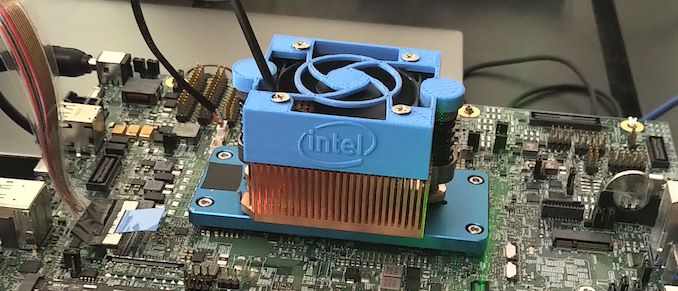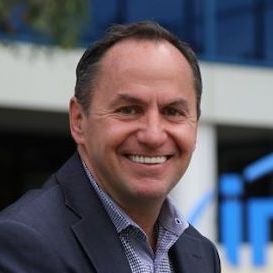Intel Reports Q4 2020 Earnings: Analyst Q&A Transcript
by Dr. Ian Cutress on January 21, 2021 6:45 PM EST- Posted in
- CPUs
- Intel
- GPUs
- Financial Results

At the end of every financial call, invited financial analysts have an opportunity to probe the key members of the company on the numbers, as well as future products. We just had Intel's Q4 2020 Financial call, covering all of Q4 developments as well as 2020 as a whole. On the call was CEO Bob Swan, CFO George Davis, Intel Chairman Omar Ishrak, and incoming CEO Pat Gelsinger.
This is a transcription with additional clarity added.
Q: Intel is set to pursue dual path manufacturing with both internal production and the use of external technology. How should we think about Intel's capital expenditure (CapEx), and its ability to secure capacity? How does porting products built for mulitple process nodes impact on operational expeditures (OpEx)? Is that what is driving higher OpEx in Q1?
Bob Swan: We have made an exhaustible effort for six months for tremendous progress on 7nm. It gives us a lot of comfort to have a predictable cadence of products, to deliver on our 2023 products, and our next generation of technology. The team has given us the confidence to leverage our IDM advantage. We are investing in technical development leadership in future. Intel’s disaggregated product designs enables Intel flexibility to see what tiles will make at Intel (majority of 2023 roadmap), but flex to make what we need to outside the company. These trade-offs include managing predictable performance gains, economics, capacity, and control of the supply chain so customers can count on delivery. It is all about maintaining Intel’s IDM advantage.
George Davis: More spending in Q1 includes AI and Xeon roadmap, as well as redirection of savings from divestitures.
Pat Gelsinger: I’ve seen the results of the great job the teams have done in last 6 months. I have confidence that most of our 2023 portfolio will be internal, but with an increasing use of foundry at the same time. I will take time to dig deeper, but I feel Intel is on a great path.
Q: Gross margin. Intel upsided for the December quarter, but going into March can Intel get better leverage on gross margin?
George Davis: Q1 was atypical seasonality. We had a digestion phase, but now we have had three quarters of digestion. That has a significant impact on mix that affects ASPs (average selling prices). We have had tremendous demand in PCs, above our expectations. The beat our initial expectations in Q4 will continue to grow in Q1 into H1. This has been more of our small core type devices, so ASP mix will be lower there. Some higher 7nm costs are impacting the outlook for gross margin, but we are getting the benefit of NAND divestiture. We are making more savings in 10nm as we are making more progress than we were expecting. 10nm is accelerating, and we're pleased with that. As you think about the year ahead, Q1 was atypical, and impacted ASPs in CCG and DCG, which makes full year extrapolation difficult. Higher 10nm over 2021 will impact gross margin, but the client mix is weighted on small core. On DC (datacenter), continue to have competitive pressures on DCG, but it’s a cost story about 10nm. We are much further along on 10nm maturity, so won't be as impactful as CCG last year. For DCG, Optane will have some margin impact.
Bob Swan: History is a good indicator for 2021: if you go back a year, we said gross margin would be 59% for 2020, and we ended up down 1.5% over what we thought at 57.5%. Drivers were $4B revenue higher than we thought, because volume was higher. Volume was all good things to foreshadow good 2021. Demand for 10nm product was higher than expected, that was positive in income, but degradation on gross margin due to ASP mix on lower core counts. PC demand over course of year was off the charts, including we believe share gains in Q4, including in consumer, entry, and education. These are typical low gross margin areas, but we had strong demand. This was the segment we couldn’t fill when we were capacity constrained last year. This increased demand at lower end drove revenue but suppressed margins. 2021 will have better mix due to (1) exit of modem and NAND, (2) 10nm cost lower, (3) 14nm fully depreciated equipment. There are two issues to note, (1) mix dynamics of PC TAM strong but at lower end due to education, and (2) renewed commitment to 7nm process tech, so degradation there. So revenue up in 2021 as adoption of 10nm and lower end were very impacts for earnings. We will see these trends through 2021.
Q: 7nm progress. In July 2020, you said first client product in the first half of 2023. Is that still on track?
Bob Swan: Yes. At the time, we said product difficulties would shift product a couple quarters. Expectation is that we will deliver client first, then server. We're improving 7nm to hit that cadence of leadership products in 2023.
Q: As Intel gets to 7nm by 2023, the competition will be one effective node head. TSMC plans to ramp N3 in 2022, and bigger ramp by 2023, while Intel is still ramping its 7nm. What does Intel need to do to match or leapfrog? In those 2-3 years while 10nm/7nm has had issues, the competition is making progress. What is the conceptual state of Intel competitive play when we get to 2023?
Bob Swan: Two points.
(1) Our belief on delivering leadership products. Process technology is very important, but also packaging technology, having a multitude of architectures (CPU to XPU), memory, security, software. The six pillars of technology required to deliver product leadership. Process is important but not the only thing.
(2) We're going to continue to invest in process tech. Some of the progress we made in 7nm is important for the next gen of product. As we leverage six pillars, we will also continue to invest in next gen beyond 7nm,
Pat Gelsinger: Majority of our products in 2023 will be on Intel’s 7nm, but we will have increasing use of external foundry. Intel is committed to building a competitive product with leadership in the marketplace. This means packaging, software, external and internal fabs, and we are confident in delivering a product leadership across all categories. Long term innovations are coming out of research as we look to close gaps and leap ahead of external foundries. Unquestioned leadership in process is our goal. IDM model means we can leverage supply to meet our customers that our competitors don't have. We want to have an unquestionable leadership product.
Q: What appealed to you at this opportunity at Intel compared to your role at VMware, especially given Intel's challenges that Bob inherited? What made you take the role?
Pat Gelsinger: Intel is a great company, it is one that I have great history with. Grove, Moore, Noyce: I grew up at their feet. It is a privilege to get my dream job. Intel is also a national asset for semiconductor technology in America. This is an opportunity to help to put Intel and USA in a technology leadership position. It is also exciting to see the unity of the board in calling me to the role. I am working close to the board, and aligning on a look forward strategy. I was enjoying time at VMWare, but the opportunity at Intel was good. Note that Intel has been through cycles before - periods where we were ahead, where we were behind. I was involved when Intel was late to multicore, and we turned around the company and took the leadership position. Great companies can come back from periods of difficulty, and they come back stronger and more capable than ever. That's the opportunity at Intel. I look forward to being part of that.
Q: Stacy: Intel said for a year that 7nm was great, and then in July it wasn't and had a delay. Now you say after a brief look at the data, it's now on track? What are you seeing that gives you that confidence, and what does that mean for other nodes?
Pat Gelsinger: Bob and the team have been working for six months on this. I'm looking at thoroughly analyzed data. I looked at that data and came to the same conclusion as Bob and his team. We're also pausing to look deeper into the roadmap for more clarity in the future. We also have adjustments in leadership too, also making adjustments in product leadership team over time. One of my favorite engineers Glenn Hinton announced he was coming back to the company today. The key leaders are coming back to Intel. Leadership, roadmap, a few more weeks of analysis will allow us to put Intel on a path.
Q: Strong performance last year on DC was penetration of Xeon, ASICS, 5G, as they continue to develop. This drove +50% for DC adjacencies at the time. So given the continued buildout of 5G, is there more double-digit growth?
Bob Swan: We view 5G and network transformation as a significant opportunity for Intel's role as compute moves DC to cloud to the network. Dumb pipes become smart pipes. We have made tremendous progress for general purpose compute in the network – it is a big source of growth, from a 1B business when we started to a 5B business last year. That came by leveraging the core GPU in the network environment. We expanded the role as more and more happened at the network. That included the radio access space with general purpose compute, but also custom architectures like FPGAs and ASICs. Having more technology here allows us to play a bigger role in our customer success. It has been a key target for Intel for a while. We've targeted 40% share in that radio share by 2022, and we hit 40% share in 2020. The role we play is much bigger, and we’ve developed lots of partnerships. It is these complimentary capabilities that will allow us to play a bigger role.
Pat Gelsinger: Bob and I struck a partnership while I was at VMWare about 5G. There are opportunities in 5G as it becomes a horizontal vs a vertical industry. 5G is a platform that redefines smart cities. It's a powerful technology. Intel is establishing a beachhead in an important market, and it has redefining redistributed computing. We will be harvesting this leadership position for a decade.
Q: No secret that Intel's success is critical to Intel competitiveness on several pillars. How much does Pat Gelsinger influence that, and the dynamics and discussion with US Government?
Omar: The Intel board has a succession planning progress. We felt that this was the right time. There has been no real government influence in our decisions, it has all been part of the regular process. We are delighted to have Pat join us at this time, and we give thanks to Bob for all his hard work at the company. But there is no other motive.
Bob Swan: To add to this, we have been talking for a couple years with US Government about the implications of the increased trade tariffs - at the time we saw that as a challenge because China is a large market. But also opportunity: (1) in the event of an east vs west scenario, we saw a bigger role for Intel in 5G. As a result of investments, team has made improvements in 5G. (2) Addressing needs in east vs west with dual supply chains, with increased supply chains, having increased tech dependencies in the east. So we have engaged both with US Government and commercial players concerned about exposures. What we've heard is that we need access to advanced microelectronics and fabrication here in the US. We need a greater industrial manufacturing based in US. We need a safe and secure supply chain in US. This is both for government and commercial customers, and we're the only company to check all the boxes. We told US Government we would be in the position to, for the good of the country, we would leverage our competitiveness to provide foundry services to the US Government. Foundry services require scale, and we need the technology to meet the government needs and commercial needs. We think we've played a role in semiconductor industry in trying to shape some of those incentives coming out of Washington that do a more effective job of leveling the playing field to invest in services here in the US.
Q: For Intel’s IDM vs Foundry, in a recent interview Bob you mentioned that licensing a third party process rather than outsourcing was on the table. That would be a shift in Intel’s philosophy. Is this something remotely on the table still?
Bob Swan: What I said is that our focus is on how you deliver regular cadence, IDM advantages, and invest in the future. As a company, we need be more open with the ecosystem, embrace our technology with other technologies. We are engaging with the ecosystem in a more holistic way. That may mean sharing our technology with others, or leveraging technology from others. It goes back to how we take this IDM business model, where we co-opt design and manufacturing, make the money, control the supply chain - how do we evolve that model.
Pat Gelsinger: This is a topic that we will discuss as we go forward with Intel. The ability to work closely with suppliers and other technology partners in the industry is critical. For innovation, we want to lead the industry consistently, whether that means moving and using what we need to inside or outside the company.
Q: As Pat takes the role, what are his key priorities?
Pat Gelsinger: It is incredible to come back home. This is my dream job. There are four areas I will focus on.
First is for Intel to have great product. We will be the leader in each category for which we play. We will deliver leadership products and have the consistent development machine to do that.
Second is Execution. We will have the best abilities to execute on our roadmap, and our roadmap to be the best. We want to deliver the best products, and make sure our customers can rely on us.
Third is Innovation. We want to be a continual delivery vehicle for innovation in the industry. This means leveraging our IDM model, our 7nm process. We have and need radical areas to innovate. More and more of every aspect of humanity is coming online, and Intel needs to be there.
Finally it is also a point of Intel’s culture. I trained at the feet of Grove, and we will have the Grovean attitude to execution. This will be data driven as we rebuild the company. The best days for Intel are in front of us. This is a priority for Intel, the industry, and our nation.












24 Comments
View All Comments
dotjaz - Sunday, January 31, 2021 - link
Not 2 nodes behind. Intel's 7nm will be over 200MT/sqmm, that's denser than N5 even N4. By 2023, TSMC will only be less than a full node ahead if Intel 7nm can deliver on time.Valantar - Saturday, January 23, 2021 - link
This Q&A was a prime use case for the BS identifyer bookmarklet (https://mourner.github.io/bullshit.js/). 108 counts of BS filtered out makes for much smoother reading, even if some of the words filtered out do actually make sense in this context.I really wish executives could ditch their nonsensical buzzword bingo financial analyst-pleasing sociolect and actually use words that mean things.
Deicidium369 - Saturday, January 23, 2021 - link
If you want smaller words and less "buzzwords" then read what the CEO of an ice cream company has to say."I really wish executives could ditch their nonsensical buzzword bingo financial analyst-pleasing sociolect and actually use words that mean things."
I am assuming you mean lingo and not bingo (this forum software needs to be updated to allow corrections - and to show more than 4 lines when you are composing a post)
This is one of the most technical companies and industry in the world - and trying to please the Wall Street Casino Analysts is meaningless - they are up to their necks in the AMD pump n dump.
I ran that program, and it filtered out your posts ... weird.
outsideloop - Thursday, January 28, 2021 - link
Ok, thanks Intel for all that.Now, for some REALITY:
TSMC isn't going to just give Intel a ton of capacity so Intel can remain competitive. Not when TSMCs goal is to ANNIHILATE Intel and take their high-margin CPU production business. TSMC will fab some GPUs for Intel and slowly bleed them down, while FULLY SUPPORTING their champion, and weapon, AMD.
All of Gelsinger's talk, Intels well-laid plans, and these "TSMC producing Intel CPU" rumors will not change the fact that AMD has 7nm+ chiplets, 64-core server processors, superior mobile silicon, superior desktop silicon, working 5nm Zen 4 prototypes, MCM GPU plans, and a CEO and team that continues to execute, quarter after quarter, year after year.
TSMC is not going to fab Intel's high-end processors in volume. Gelsinger has stated this, and it is not in TSMCs interest.
I posed this question two years ago: Who do you trust to execute for the next several years? Intel, after delaying 10nm for over FOUR years? Or TSMC and AMD, who have been executing perfectly in those four years?